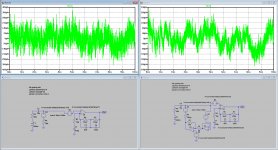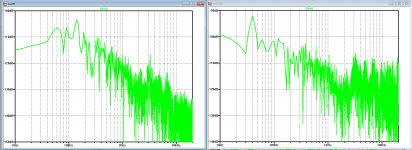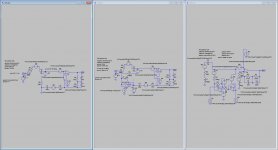Thanks for the graphs, Hans!
I suppose to some extent this is true, but in a properly aligned set-up the vertical rumble, which tends to be far more obtrusive than lateral rumble, should be almost completely antiphase (at least to within 26dB).
The out of phase is just hypothetical, because cart signals are never completely out of phase.
I suppose to some extent this is true, but in a properly aligned set-up the vertical rumble, which tends to be far more obtrusive than lateral rumble, should be almost completely antiphase (at least to within 26dB).
But is not only the cart. What value did D Self use for the 1.2Meg Ohm that I used in the feedback.
Different value, different outcome.
I managed to find Self's circuit from Google book samples. It looks a little unwieldy to me, with resistor values in the inverting stage considerably higher than what I would consider ideal
Attachments
Actually the LM4562 / LME49720 has a disadvantage in this application. The NE5534A is quieter due to low current noise.
I'd imagine the greater improvement is from the op-amp in this case being very low noise. Don't forget that the virtual earth generated by the inverting stage will also contribute noise to the very sensitive bottom part of the feedback network.
The LME49720 is about 6dB quieter than the NE5532, which gives a fair bit of scope for much better noise performance when used with this topology.
Comparing apples with pears always leads to guesswork, so I simulated the circuit from D.Self.
As Monty already suggested, performance increase depends largely on the used Op-Amp but also on the used topology.
There are 5534's wit 3.5nV/rtHz, but also 5nV/rtHz.
And there is also the Monty op-amp with 2.7nV/rtHz.
the outcome in noise at the output is for both topologies:
2.7 nV/rtHz: 38uV vs 86uV, an improvement of 7.6 dB
3.5 nV/rtHz: 46uV vs 90uV, an improvement of 5.8 dB
5.0 nV/rtHz: 62uV vs 99uV, an improvement of 4.1 dB
I still did not take into account the noise produced by the 600Ohm Cart resistor, generating another 3,5 nV/rtHz, reducing the gain in noise even further, but enough is enough.
I have proved sufficiently that D. Selfs circuit diagram is inferior to Monty's circuit, in which I have included ALL noise sources when giving the 12 dB improvement.

Hans
I redid the test with added noise for the 600 Ohm cart resistor and for a 5nV/rtHz op-amp.
Output noise was resp: 90uV vs 120uV, an improvement of 2.5 dB.
This corresponds probably to the D. Self figure.
As Monty already suggested, performance increase depends largely on the used Op-Amp but also on the used topology.
There are 5534's wit 3.5nV/rtHz, but also 5nV/rtHz.
And there is also the Monty op-amp with 2.7nV/rtHz.
the outcome in noise at the output is for both topologies:
2.7 nV/rtHz: 38uV vs 86uV, an improvement of 7.6 dB
3.5 nV/rtHz: 46uV vs 90uV, an improvement of 5.8 dB
5.0 nV/rtHz: 62uV vs 99uV, an improvement of 4.1 dB
I still did not take into account the noise produced by the 600Ohm Cart resistor, generating another 3,5 nV/rtHz, reducing the gain in noise even further, but enough is enough.
I have proved sufficiently that D. Selfs circuit diagram is inferior to Monty's circuit, in which I have included ALL noise sources when giving the 12 dB improvement.

Hans
I redid the test with added noise for the 600 Ohm cart resistor and for a 5nV/rtHz op-amp.
Output noise was resp: 90uV vs 120uV, an improvement of 2.5 dB.
This corresponds probably to the D. Self figure.
Last edited:
Actually the LM4562 / LME49720 has a disadvantage in this application. The NE5534A is quieter due to low current noise.
Sorry, this is just some opinion not based on any fact at all.
Hans
Actually the LM4562 / LME49720 has a disadvantage in this application. The NE5534A is quieter due to low current noise.
There is that, but bearing in mind that most of the resistive elements are quite low in value, the current noise shouldn't degrade the performance by more than 3dB or so.
As Self is connecting 2 op-amps to the cartridge input, as opposed to just one, the current noise is also doubled. I have no idea why he didn't choose to do it the conventional way and save an op-amp...
Looks like a job for you, Hans
Mea culpa,
I made a scaling error in the noise sources in the Monty diagram.
The Monty circuit has resp 34uV and 89uV output noise.
This includes all noise sources, voltage and current.
The improvement therefore is not 12dB but 8.4dB.
Still a lot better that D Self's circuit.
Hans
I made a scaling error in the noise sources in the Monty diagram.
The Monty circuit has resp 34uV and 89uV output noise.
This includes all noise sources, voltage and current.
The improvement therefore is not 12dB but 8.4dB.
Still a lot better that D Self's circuit.
Hans
the current noise is also doubled.
Looks like a job for you, Hans.
No noise adds rms it's 3dB.
I already knew this, my mistake for phrasing it that way, thoughNo noise adds rms it's 3dB.
Hi Monty,
I went one stage deeper, and added all voltage and current noises in the circuit diagram.
Hans
Where's the RIAA shape in the noise, I never saw a pre-amp noise floor that didn't show the 40dB difference from 20Hz to 20kHz?
Where's the RIAA shape in the noise, I never saw a pre-amp noise floor that didn't show the 40dB difference from 20Hz to 20kHz?
That is because you are used looking at noise shapes with the input shorted.
In this case there is a cart at the input.
See the difference below, not averaged over several samples as you normally see.

Hans
That is because you are used looking at noise shapes with the input shorted.
In this case there is a cart at the input.
See the difference below, not averaged over several samples as you normally see.
View attachment 547160
Hans
OK, now explain how a shorted input cares about source resistance.
If this is a question, I don't understand.OK, now explain how a shorted input cares about source resistance.
Hans
If this is a question, I don't understand.
Hans
If you replace the cartridge with a short the source resistance does not matter but I see you probably mean the node labeled input on your schematic. Then in that case how do you account for less noise below 100Hz where the source resistance is that of the DC coil resistance (600 Ohms) and the source 47K or the synthesized smaller one don't matter?
Drat! I completely forgot input noise current, which due to the high source impedance (especially at higher frequencies) will compromise the noise performance much more than the input noise voltage...
I think a JFET op-amp is needed. Perhaps an OPA2134.
As you can see in posting #32, I had inserted the current noise B2, generating 1.6pA/rtHz in the negative input of U1.
Placing it in the positive input, makes a huge difference.
So I will redo all simulations tomorrow, yours as also D. Self's version.
And this time I will check and recheck before posting, placing all noise generators at the critical spots.
I never intended investing so much time in this, but things have to be right.
Hans
If you replace the cartridge with a short the source resistance does not matter but I see you probably mean the node labeled input on your schematic. Then in that case how do you account for less noise below 100Hz where the source resistance is that of the DC coil resistance (600 Ohms) and the source 47K or the synthesized smaller one don't matter?
With shorting I mean putting the left side of C5 to ground, thus replacing the cart by a short circuit.
As you can see noise at 100Hz is some 10dB lower as with the cart in place, which makes perfectly sense, because the 600 Ohm with 3.5nV/rtHz is no longer part of the equation.
Hans
With shorting I mean putting the left side of C5 to ground, thus replacing the cart by a short circuit.
Hans
In that case the source, 50K on the right, and the op-amp with 1.2M making a 50K "cold " resistor on the left, are both shorted to ground i.e. they can't matter. Why 10 or 12dB noise difference?
It was a hell of an exercise, that I never should have started in the first place.
But I took the challenge and I had to bring it to an end, after having done things too rapidly to start with, resulting in errors.
With noiseless op-amps, Monty's topology can achieve 5.4dB max gain in noise performance with regard to a "normal" 50KOhm resistor and with the D. Self setup a theoretical max of 5.0dB is achievable.
With the best performing op-amp in this experiment, an OPA827, this theoretical 5.4dB max gain dropped to 3.6dB with Monty and to an ever smaller 1.9dB gain with D. Self.
In all cases an OPA2134 is a bad choice and the NE5534 is not among the top performers either.
In the D. Self diagram, gain in noise performance with the 5534 was just 0.4dB. Not even worth considering.
With a straightforward 50K resistor, the OPA1632 was the best performer with 106uV output noise.
unweighted SNR ref 5mV@1khz with this op-amp will be 73,5dB, or something like 77,5dB A, including the cart!
This is more than excellent for the most critical application, so after all I see little advantage in using the more complex feedback topology.
So here are the results.
View attachment RIAA.pdf
taken with these 3 configurations, resp a straightforward 50KOhm, Monty circuit diagram and D. Self´s diagram.

Hans
But I took the challenge and I had to bring it to an end, after having done things too rapidly to start with, resulting in errors.
With noiseless op-amps, Monty's topology can achieve 5.4dB max gain in noise performance with regard to a "normal" 50KOhm resistor and with the D. Self setup a theoretical max of 5.0dB is achievable.
With the best performing op-amp in this experiment, an OPA827, this theoretical 5.4dB max gain dropped to 3.6dB with Monty and to an ever smaller 1.9dB gain with D. Self.
In all cases an OPA2134 is a bad choice and the NE5534 is not among the top performers either.
In the D. Self diagram, gain in noise performance with the 5534 was just 0.4dB. Not even worth considering.
With a straightforward 50K resistor, the OPA1632 was the best performer with 106uV output noise.
unweighted SNR ref 5mV@1khz with this op-amp will be 73,5dB, or something like 77,5dB A, including the cart!
This is more than excellent for the most critical application, so after all I see little advantage in using the more complex feedback topology.
So here are the results.
View attachment RIAA.pdf
taken with these 3 configurations, resp a straightforward 50KOhm, Monty circuit diagram and D. Self´s diagram.

Hans
Sorry, this is just some opinion not based on any fact at all.
Hans
Another one switching off his brain when switching on the simulator?
At 1kHz a 1kOhm/500 mH cartride has about 4kOhm impedance.
The LM4562 current noise alone will therefore produce
1.6n * 4k = 6.4 nV => bad Opamp choice.
- Status
- This old topic is closed. If you want to reopen this topic, contact a moderator using the "Report Post" button.
- Home
- Source & Line
- Analogue Source
- Deluxe Phonostage with Vertical Rumble Filter
